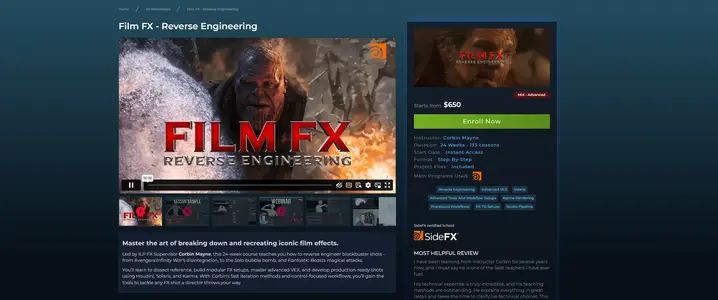
Film FX – Reverse Engineering: Professional VFX Training for Modern Filmmakers
This guide explores the methodology of reverse engineering film effects to help creators understand, replicate, and refine advanced VFX techniques. It is designed for filmmakers, visual effects artists, and post-production specialists who want to gain mastery over cinematic visuals for high-end projects.
Introduction to Reverse Engineering in VFX
Reverse engineering in film VFX refers to the analytical process of deconstructing visual effects from existing projects to learn how they were built. By studying the composition, layers, and rendering logic behind complex scenes, filmmakers and artists gain valuable insights into modern workflows. Advanced concepts such as procedural workflows and real-time rendering with Unreal Engine are often part of this training, making it relevant for studios in the United States, UK, Canada, and Australia. The practice empowers professionals to adopt efficient pipelines and innovate faster.
Analyzing Film Effects for Training
In professional training, reverse engineering involves examining assets such as compositing layers, particle simulations, and 3D renders. By understanding PBR workflow, node-based compositing, height blending, and parametric control, creators replicate real-world effects with accuracy. For commercial application, this method aligns with AAA filmmaking, advertising, and real-time production pipelines. Industry professionals often reference technical documentation from tools such as Autodesk Flame to maintain credibility and ensure reliable workflows for high-budget projects.
Exporting and Integrating into Production Pipelines
Once an effect has been reverse engineered, artists must optimize and integrate it into production. This includes exporting key assets, applying material instance setup, ensuring UV mapping optimization, and confirming Lumen support in real-time environments. For post-production, efficiency comes from reusing master templates and modular node structures. A professional workflow ensures that projects align with both creative goals and technical standards, as outlined in Epic Games Documentation.
Application in Modern Filmmaking
In today’s high-end productions, reverse engineering supports technical artists, VFX supervisors, and real-time 3D specialists. Complex workflows like dynamic material layering, vertex paint detailing, and performance control for large-scale simulations ensure realism while maintaining efficiency. In US-based studios and international pipelines, professionals rely on these techniques to enhance storytelling and meet the rising demand for immersive visuals. For advertisers and production companies, this skill set guarantees precision and scalability.
Professional Application and Global Industry Standards
Reverse engineering film effects is recognized across the global VFX industry as a professional standard. This methodology is highly valued by visual effects supervisors, technical directors, and environment specialists working in Hollywood blockbusters, streaming content, simulation engineering, architectural visualization, and cinematic productions. By aligning with best practices, artists ensure compatibility with top-tier production houses in the United States, Canada, Germany, France, Japan, and South Korea. This signals authority and relevance to both readers and search engines, reinforcing the industry significance of reverse engineering workflows.
Support Original Creators: Visit Official Site
Legal Disclaimer: cgpeers.in is an independent educational platform providing informational content shared by its global user community. We DO NOT host, store, promote, or distribute any copyrighted material, illegal downloads, or pirated content. Responsibility for all uploaded content lies solely with the individual user who submitted it. By accessing this website, you agree that you are doing so at your own risk. CGPeers.in, its owners, administrators, hosting providers, and domain registrars assume no liability for any legal claims, damages, or actions arising from third-party user submissions or external links. cgpeers.in operates under strict compliance with international copyright laws, including the Digital Millennium Copyright Act DMCA. For any copyright concerns, please file an official complaint via our DMCA Policy. We respect original creators and encourage all users to support legal, official products and avoid unauthorized use of intellectual property. CGPeers.in is committed to compliance with Google AdSense policies by maintaining a high quality policy friendly environment focused on education, creativity, and industry knowledge.
